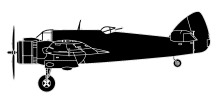
ASN Wikibase Occurrence # 239865
This information is added by users of ASN. Neither ASN nor the Flight Safety Foundation are responsible for the completeness or correctness of this information.
If you feel this information is incomplete or incorrect, you can submit corrected information.
| Date: | Sunday 23 July 1944 |
| Time: | |
| Type: |  Bristol Beaufighter TF Mk X |
| Owner/operator: | 603 (City of Edinburgh) Sqn RAF |
| Registration: | NE610 |
| MSN: | |
| Fatalities: | Fatalities: 1 / Occupants: 2 |
| Aircraft damage: | Destroyed |
| Location: | Mediterranean Sea near Mykonos. -
 Greece Greece
|
| Phase: | Combat |
| Nature: | Military |
| Departure airport: | LG 143 Gambut 3, Libya |
Beaufighter NE610/X: Missing, presumed ditched, returning from shipping strike off Mykonos. 23/07/1944
Crew:
F/O. (????) K. JENKINSON (pilot) RAFVR - Safe. Picked up by destroyer
F/Sgt.(1601225) Jeffrey James ROGERS (nav.) RAFVR - killed
Short story for that day:
S/L. Deck, DFC, led an offensive reconnaissance over the central Aegean. At 08:50 hrs an Arado was seen ten miles east of Mykonos and the formation went into attack. It was shot down. Beaufighter "A" reported damage and was told to return to base with "N" as escort. Unable to maintain height, "A" was ditched, but both members of the crew—F/O. Bounevialle,D.F.C., and F/Sgt. Potter were seen to get into their dinghy. Meanwhile the other four Beaus had found a convoy of some seven vessels. In the attack which followed, a corvette and an auxiliary sailing-ship were both damaged, but Beaufighter "H"
was seen to break away with smoke coming from the starboard engine. It was put safely in the water and W/O. Sykes and F/Sgt. Foxley were seen to get into their dinghy. The pilot of "C", F/Sgt. Pennie, reported that he had been seriously wounded; he was instructed to increase speed in order to get home quickly.
The leader in " P " acted as escort, and "X", which was experiencing trouble with one petrol cock, was given permission to leave the formation and fly more slowly to increase range. It was never seen again. "N" returned safely independently.
A later report said that one of the crews had been picked up by the Royal Navy; and another pilot, F/O. K. Jenkinson, was picked up after spending sixand-a-half days in his dinghy.
Apparently he had had his starboard engine hit by flak and later the petrol feed to the port engine failed.
In the resulting ditching his navigator was washed away and never seen again. Jenkinson had with him only two packets of chewing gum, a bar of chocolate and a few barley-sugar drops. He bandaged his wounds with pieces torn from his parachute.
On the first day a Wellington passed over but failed to see the Very lights which he fired; and on the second day a Beaufighter went by almost exactly overhead and also failed to see the dinghy.
He had no drinking water, so periodically he washed his teeth in salt water and gargled with it to relieve his thirst. The weather became bad and several times he was thrown out of his dinghy into the sea.
For the next four days Jenkinson drifted, sleeping at times but not,
curiously enough, feeling badly the effects of hunger or thirst. He had a recurrent dream that he was rescued by a submarine, the commander of which questioned him as to how long he had been
adrift. When told "five days," the submariner said: "You are not time-expired yet, you have still a couple of days to go"—and then put him in the sea again. And it was in the early evening of the seventh day that Jenkinson saw a convoy and fired his last three cartridges. Two, wet, misfired; the third was all right. He then had the mortification of watching the convoy alter course away from him. For a while all seemed hopeless, and he lay down to sleep. But a little later he heard the approach of a vessel. It was a British destroyer HMS Lauderdale; he had been seen, and a boat was being lowered. No longer able to stand the suspense, he dived into the sea to swim towards his rescuers. Safely on board, he was taken to the sick bay; but very soon he was able to face a bottle of beer in the wardroom. In the period he was adrift he lost some 28 lb in weight.
Sources:
1.http://aviationarchaeology.gr/wp-content/uploads/2014/07/Beaufighter-losses-in-Greece-1941-19464.pdf
2.CWGC
3.POW
Revision history:
| Date/time | Contributor | Updates |
|---|---|---|
| 12-Aug-2020 10:23 | Nepa | Added [Operator] |
| 01-Nov-2022 10:20 | Nepa | Updated [Source, Narrative, Operator] |
Corrections or additions? ... Edit this accident description
The Aviation Safety Network is an exclusive service provided by:


 ©2024 Flight Safety Foundation
©2024 Flight Safety Foundation